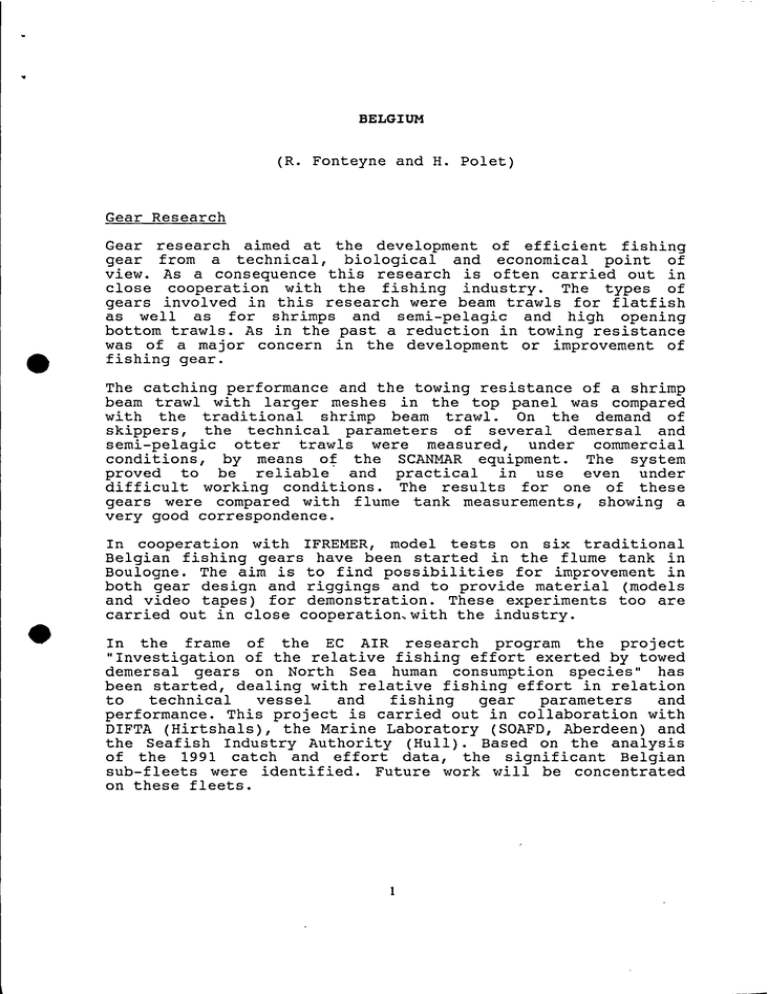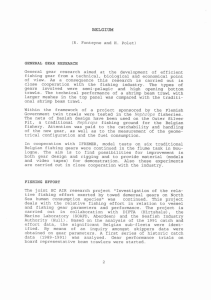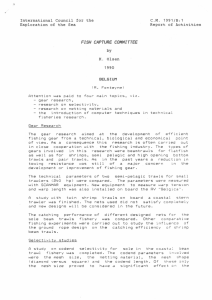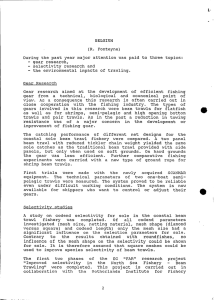(R. Fonteyne and H. Polet) Gear Research Gear research
advertisement

BELGIUM (R. Fonteyne and H. Polet) Gear Research Gear research aimed at the development of efficient fishing gear from a technical, biological and economical point of view. As a consequence this research is often carried out in close cooperation with the fishing industry. The types of gears involved in this research were beam trawls for flatfish as well as for shrimps and semi-pelagic and high opening bottom trawls. As in the past a reduction in towing resistance was of a major concern in the development or improvement of fishing gear. The catching performance and the towing resistance of a shrimp beam trawl with larger meshes in the top panel was compared with the traditional shrimp beam trawl. On the demand of skippers, the technical parameters of several demersal and semi-pelagic otter trawls were measured, under commercial condi tions, by means o~ the SCANMAR equipment. The system proved to be reliable and practical in use even under difficult working conditions. The results for one of these gears were compared with flume tank measurements, showing a very good correspondence. In cooperation with IFREMER, model tests on six traditional Belgian fishing gears have been started in the flume tank in Boulogne. The aim is to find possibilities for improvement in both gear design and riggings and to provide material (models and video tapes) for demonstration. These experiments too are carried out in close cooperation,with the industry. In the frame of the EC AIR research program the project "Investigation of the relative fishing effort exerted by towed demersal gears on North Sea human consumption species" has been started, dealing with relative fishing effort in relation to technical vessel and fis hing gear parameters and performance. This project is carried out in collaboration with DIFTA (Hirtshals), the Marine Laboratory (SOAFD, Aberdeen) and the Seafish Industry Authority (Hull). Based on the analysis of the 1991 catch and effort data, the significant Belgian sub-fleets were identified. Future work \'Till be concentrated on these fleets. 1 Selectivity studies The development of a species selective beam trawl, with special emphasis on a substantial decrease of young roundfish discards while maintaining the level of flatfish catches has been the subject for the EC "FAR" research project "Improved selectivity in the North Sea Fishery - Beam Trawling". This project has been carried out in collaboration with the Netherlands Institute for Fishery Investigations (RIVO, Ijmuiden) and the Seafish Industry Authority (Hull). The designs of the species selective beam trawls were adjusted and completed by means of flume tank experiments in Hull. The full scale gears were tested on a commercial beam trawler. The experimental gears and the fish reactions were studied with RIVO's ROV operated from the Dutch RV ISIS. During three trips on a commercial vessel the catches of the selective configurations were compared with the ones of the traditional beam trawl. Good resul ts were obtained in releasing haddock and whiting, but for cod the results were not yet consistent. No meaningful los ses in flatfish catches were noted. The study has been completed with a financial evaluation of the selective gears, showing only a marginal decrease in returns. A proposal for a new EC project on the optimisation of the species selective beam trawls has been submitted under the AIR research program. In due time a new project will start, as a continuation, on the optimisation of the species selective beam trawls. A first series of experiments have been carried out on the influence of towing speed on the by-catch of roundfish and the codend selectivity of a 4m beam trawl. At the same time a codend cover with hoops was tested out but appeared not to be able to withstand the harsh conditions in beam trawling. Further experiments with stronger materials will follow. An EC financed project on the selectivity of traditional Belgian Nephrops trawls and discarding practices in this fishery has been started. Together with the selectivity parameters of a 70 mm and a 90 mm codend the consequences of the application of a square mesh window will be determined. The results will be compared with those of a parallel project by DIFTA, Denmark. Together with the Seafish Industry Authority (Hull) an EC seminar with professional fishermen on discarding and possible solutions for this problem was organised in Ostend. Cooperation has been given to the FTFB-subgroup dealing with the design, performance and analysis of selectivity experiments. 2 Technical/ecological aspects of trawling. The EC FAR project "Environmental impact of bottom gears on benthic fauna in relation to natural resources management and protection of the North Sea" was continued. This project is carried out in collaboration with institutes from the Netherlands, Germany and the UK. On the research vessel BELGICA the tracks of a 4 m beam trawl were studied by means of side scan sonar techniques and in situ inspection by divers. The pressure exerted by the sole plate of the beam trawl on the bottom was measured. For this purpose an instrumented beam trawl head has been developed. At the same time changes in the benthos population due to fishing operations as weIl as survival of the organisms caught were studied by the Dutch institute NIOO CEMO. Other activities. The inventory of net plans Belgium was continued. and rigging of gears in use in On the demand of a Dutch manufacturer of synthetic fibres a series of tests has been started to study the abrasion and mesh stability of netting made of a new synthetic fibre. 3








